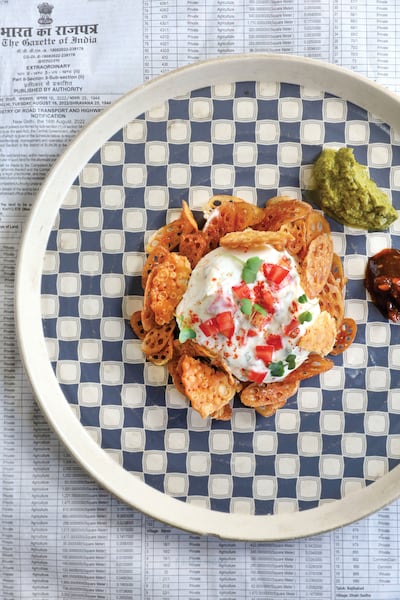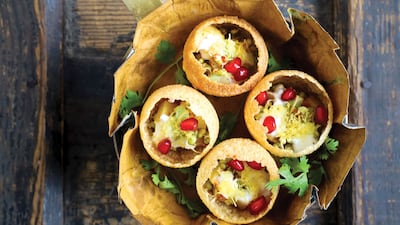India lives on its street food. Day or night, north or south, there’s something to be savoured around every corner. Especially chaat, an entire food category that defies description and is an addictive combination of sweet, salty, sour, tangy, spicy, crispy and crunchy flavours and textures.
While this quintessential street food has moved into fancy restaurants, almost everyone swears their soul food comes from a favourite roadside stall or push-cart. The pandemic and the ensuing lockdowns brought the industry to a crashing halt. Like many others, author Sonal Ved missed chaat so much she began making it at home, leading to her new book India Local: Classic Street Food Recipes (Roli Books), a loving rumination on India’s street food, out on August 30.
For Ved, the play on temperature, texture and colour of chaat epitomises Indian food. “Indian food overall can be summed up with these words – temperature, texture and colour, and chaat has all of that. For me chaat is an ideal representation of Indian cuisine abroad. The way tapas is for Spain, I think chaat and street food is that for India,” she says.

The book is an ode to the country’s regional diversity seen through the lens of street food. Replete with chaat and street food recipes from all over the country and seasoned with stories, the book took almost two years to come together.
Ved's passion for food is clear, and for readers it is elevated by her attention to detail and evocative storytelling. This is evident in her first book, Tiffin: 500 Authentic Recipes Celebrating India’s Regional Cuisine, (Roli Books, 2018) and is the backbone of Whose Samosa Is It Anyway? (Penguin Random House, 2021), a book that examines the global influences on Indian food from the times of the Indus Valley Civilisation to the present. Before these, in 2016, she put together Gujju Goes Gourmet, published as a digital book primarily for mobile phones.
Ved is obsessed with origin stories. She talks about the roots of chaat and the differing stories: one posits that 16th-century Emperor Shah Jahan was prescribed spice-loaded foods to boost immunity during illness, while another suggests that court hakims told Delhi’s citizens to cook with herbs and spices to counter polluted river water. She knows these to be tales and points out that the 12th-century Sanskrit text Manasollasa indicates the existence of versions of some popular types of chaat. “Though chaat may have become well defined during the Mughal period, they existed in various forms earlier too,” she writes in the introduction.

She defines the dish, saying: “All chaat is street food, but not all street food is chaat.” But she is more fascinated by the unique back stories of many of the dishes. “When I started putting geographical identification to street foods I realised that not everything is north-centric. There is this perception that all chaat is Lucknowi or from Indore, or at least from the general north. Of course, a lot of it is from there, but there is so much that came out of Mumbai. The city created street food culture because of industrial development and a lot of migrant workers who needed quick food,” she says.
This gave birth to some of Mumbai’s most famous street food such as Bombay sandwich (buttered bread filled with slices of boiled potatoes, beetroot, tomatoes, onions and cucumber, slathered with green chutney and spice powder), vada pav (spicy mashed potato fritter in a square bun) and pav bhaji (spongy bun served with a spicy vegetable gravy), even the street dosa (rice and lentil crepe, a South Indian breakfast staple) which has several variations.

In the process Ved stumbled upon examples of street food that are a products of historical influences. Although a noodle dish with shredded cabbage, spices and tamarind is unique to Chennai, it has overt Burmese influence brought by Burmese Indians when they returned during the 1962 coup.
And in Kolkata, Chinese immigrants produced Chinese bhel, a spicy, tangy, version of crisp noodles. Darjeeling in the Himalayan foothills is famous for lal aloo Wai Wai. She describes the preparation of this dish, using half a packet of Wai Wai noodles mixed with a hot potato and tomato curry, which is topped with the spice mix and oil from the packet. The curry poaches the noodles and then the crispy raw noodles are added. “It is eaten straight out of the packet,” she says. “It is fascinating to see people eating this all over town.” There are similar stories about Sikkimese sel roti and Indore’s egg banjo, among others, she says.
Towards the end, she lets the reader peek into her kitchen and lists chaat and street foods that she has grown up with and the recipes she has developed, such as kale chaat, quinoa and olive tikki chaat and avocado taco chaat.
Above all, it’s her evocative narrative that is compelling and enduring. It’s best exemplified by her nostalgic description of eating pani puri, the beloved and ubiquitous chaat with myriad versions and names across the country: “Moments when that puri breaks apart as you try to bite into it, and a medley of flavours explodes on your tongue and reminds you of when you climbed up trees on hot summer days to break off imli and eat it.”

